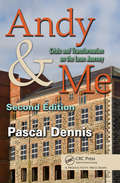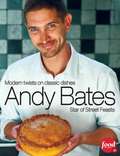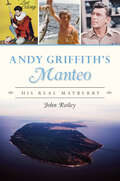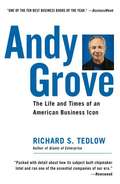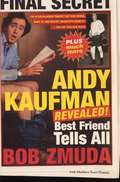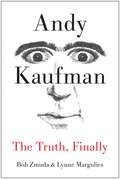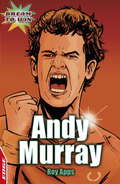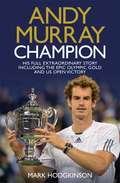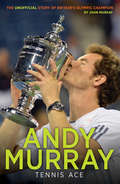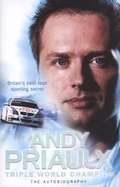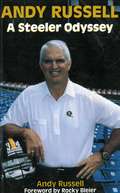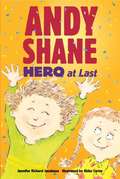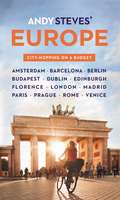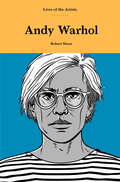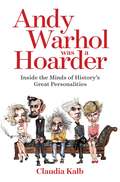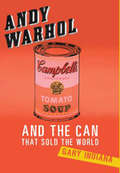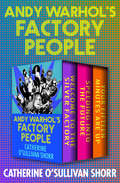- Table View
- List View
Andy & Me: Crisis & Transformation on the Lean Journey
by Pascal DennisSecond Edition of a Shingo Prize Winner Based on the author's personal experience with Toyota‘s master teachers and with companies in the midst of great change, Andy and Me: Crisis and Transformation on the Lean Journey, now in its second edition, is a business novel set in a failing New Jersey auto plant focusing on the tribulations of Tom Pappas,
Andy Bates: Modern Twists on Classic Dishes
by Andy BatesCheeky and charming chef Andy Bates, the star of the TV series Street Feasts, gives his unique twist on classic dishes. From his stall in London's Whitecross street market, Andy has seen the street food scene explode. Travelling to some of the most vibrant food destinations in Britain and the USA, and meeting people who are taking kerbside cuisine to a gourmet level, has inspired Andy to create his own modern food classics. From his award-winning pies, pastries and melt-in-your-mouth tarts, to more creative recipes incorporating international flavours, this book features more than 100 great dishes in Andy's simple, unpretentious style. Join Andy on his food journey and meet some of the colourful cooking characters he discovers along the way.
Andy Bates: Modern twists on classic dishes
by Andy BatesCheeky and charming chef Andy Bates, the star of the TV series Street Feasts, gives his unique twist on classic dishes.From his stall in London's Whitecross street market, Andy has seen the street food scene explode. Travelling to some of the most vibrant food destinations in Britain and the USA, and meeting people who are taking kerbside cuisine to a gourmet level, has inspired Andy to create his own modern food classics.From his award-winning pies, pastries and melt-in-your-mouth tarts, to more creative recipes incorporating international flavours, this book features more than 100 great dishes in Andy's simple, unpretentious style.Join Andy on his food journey and meet some of the colourful cooking characters he discovers along the way.
Andy Chew at Siemens Nixdorf: Change from the Middle
by Rosabeth Moss Kanter John F. McguireAndy Chew, a British manager reassigned to Germany by a large German computer company, is in the middle of carrying out a project as a designated "change agent" in a program to reshape the culture toward one that is more entrepreneurial for success as a nimble global competitor. He is still uncertain of his support.
Andy Griffith's Manteo: His Real Mayberry
by John RaileyLearn about the real life of beloved actor Andy Griffith.The world loves Sheriff Andy Taylor. Yet the actor who played him was intensely private. Here, for the first time, is the real Andy Griffith, his career and life defined by the island that made him in the years soon after World War II. He achieved his artistic breakthrough while acting in The Lost Colony drama on Roanoke Island, then spent the rest of his life repaying the island for giving him that start. Here, in unique closeup, is Andy of Manteo, reveling in wild, watery and loving ways with his fellow islanders. Author and journalist John Railey paints an intimate portrait of Andy, based on interviews with many of those who knew him best on the sand where he lived and died.
Andy Grove: The Life and Times of an American Business Icon
by Richard TedlowDuring Grove's career, Intel became the model for Silicon Valley. Silicon Valley became the model for the world. And Grove became Time's Man of the Year, an icon of the promise of the American life.
Andy Kaufman Revealed!: Best Friend Tells All
by Bob ZmudaBest known for his sweet-natured character Latka on Taxi, Andy Kaufman was the most influential comic of the generation that produced David Letterman, John Belushi, and Robin Williams. A regular on the early days of Saturday Night Live (where he regularly disrupted planned skits), Kaufman quickly became known for his idiosyncratic roles and for performances that crossed the boundaries of comedy, challenging expectations and shocking audiences. Kaufman's death from lung cancer at age 35 (he'd never smoked) stunned his fans and the comic community that had come to look to him as its lightning rod and standard bearer.Bob Zmuda -- Kaufman's closest friend, producer, writer, and straight man -- breaks his twenty-year silence about Kaufman and unmasks the man he knew better than anyone. He chronicles Kaufman's meteoric rise, the development of his extraordinary personas, the private man behind the driven actor and comedian, and answers the question most often asked: Did Andy Kaufman fake his own death?
Andy Kaufman: The Truth, Finally
by Bob Zmuda Lynne MarguliesFor the first time ever, the two people who knew Andy Kaufman best open up about the most enigmatic artist of our generation. Comedian and Taxi star Andy Kaufman, known for his crazy antics on screen and off, was the ultimate prankster, delighting audiences with his Elvis and Mighty Mouse impressions while also antagonizing them with his wrestling and lounge-lizard alter ego, Tony Clifton. Some say he died in 1984, while others believe he performed the ultimate vanishing act. In Andy Kaufman: The Truth, Finally, Bob Zmuda, Andy's writer and best friend, and Lynn Margulies, the love of Andy's life, reveal all—including surprising secrets that Andy made Lynne and Bob promise never to tell until both of his parents had died. Hilarious and poignant, this book separates fact from fiction, and includes a candid inside look at the Milos Forman film Man on the Moon, which Zmuda coexecutive produced and featured Jim Carrey as Andy, Paul Giamatti as Zmuda, Courtney Love as Margulies, and Danny DeVito as Andy's manager, George Shapiro. Finally, Bob Zmuda shares in detail the reasons he believes Andy Kaufman did, in fact, fake his own death, including exactly how he did it and why he will return.
Andy Murray (EDGE: Dream to Win #6)
by Roy AppsEver had a dream -- a dream to win? Andy had a dream -- to be the number one tennis player.This is the story of Andy's early years and his break through into the top ten ranking.This title is published by Franklin Watts EDGE, which produces a range of books to get children reading with confidence. We believe this title will be of interest to readers aged 7+ and to older readers who struggle with reading. EDGE - for books kids can't put down.
Andy Murray - Champion
by Mark HodgkinsonWhen Andy Murray finally overcame Novak Djokovic in a five-set thriller to secure the 2012 US Open, it was a dream fulfilled for the man from Dunblane. After four previous defeats in Grand Slam finals, Murray had finally achieved what no British man had managed since the 1930s. But the story of how he got there was just as compelling as the final itself, with as many twists and turns along the way. Writer Mark Hodgkinson has been covering that story since the start - he was actually the first person to interview Murray for a national newspaper back in 2004, and has worked closely with Judy Murray in the past. In Andy Murray: Champion, Hodgkinson explains how Murray first emerged as a tennis player of true quality, and how his rivalry with his brother Jamie spurred him on. He looks at the close relationship Murray has with his mother, and the various coaches who haved worked with him to assess their influence on his game. In a hugely competitive era of tennis, with Federer, Nadal and Djokovic all counted to be among the greatest tennis players of all time, Murray has earned the right to be ranked alongside them all - and this book explains how and why he has done so, becoming a true national sporting icon in the process.
Andy Murray: EDGE - Dream to Win
by Roy Apps Chris KingEver had a dream -- a dream to win? Andy had a dream -- to be the number one tennis player.This is the story of Andy's early years and his break through into the top ten ranking.This title is published by Franklin Watts EDGE, which produces a range of books to get children reading with confidence. We believe this title will be of interest to readers aged 7+ and to older readers who struggle with reading. EDGE - for books kids can't put down.
Andy Murray: Tennis Ace
by John MurrayHave you ever wondered what it takes to become a tennis star? This is Andy Murray’s story – from the first time he picked up a tennis racquet, to his Grand Slam win at the US Open.Did you know that Andy was approached by a major football club? Or that he used to play doubles with Novak Djokovic? Follow the Scot's rise to stardom in this brand-new biography of our tennis ace.
Andy Murray: Wimbledon Champion
by Mark HodgkinsonFew tennis players have ever had to carry the same weight of expectation from an entire nation in the way that Andy Murray has. Nor has their path to triumph been subjected to quite so much scrutiny and ill-informed comment, with his mother, his on-court anger and even his facial hair all subjected to criticism. Now, in this fascinating and revealing biography, updated and revised throughout to include his famous Wimbledon victory, Mark Hodgkinson unveils a very different Murray from the public perception, showing how his family, his coaches and his girlfriend have all helped to shape him into what he has always wanted to be: a winner. Olympic gold and two grand slam titles have taken him to a new level, and mean that Murray is now a man who has the nation behind him - and is hungry for more success.
Andy Priaulx: The Autobiography of the Three-time World Touring Car Champion
by Andy PriaulxThe inspiring autobiography of a three-time World Touring Car champion, and almost certainly Great Britain's best-kept sporting secret . . . until now! For someone who grew up on a small island with a speed limit of just 35 mph, Andy Priaulx drives his car awfully fast. But then the man from Guernsey is a hugely determined figure who has been fighting against the odds and performing the role of underdog throughout his entire career. In this his first book, Priaulx tells of how he has fought--tooth and claw, with virtually no back-up--for every sponsor, every car, and every penny on his way to achieving his dream of one day becoming a world champion. With refreshing honesty, Priaulx reveals how he and his wife risked everything financially to get on the lower rungs of the motor racing ladder, even spending some time living in a borrowed caravan at the Silverstone circuit in an attempt to save money. "Pikey Priaulx" was his nickname at the time, but the story only goes to show how sacrifice and sheer bloody-mindedness can pay off. Priaulx's reserves of energy, enthusiasm, and dedication--not to mention his natural talent--served him well as he won the European Touring Car Championship in 2004. Motor sport's governing body, the FIA, recognizes only three world championships--Formula 1, World Rally, and World Touring Cars. Priaulx has won the WTC championship for the last three years, an unprecedented achievement. In fact, such has been Priaulx's success that he has been universally hailed as the greatest touring car driver of all time, and widely dubbed "Britain's Schumacher. " In 2007 Priaulx received the ultimate accolade when he was awarded the Gold Medal of the British Racing Drivers' Club "in recognition of outstanding contemporary racing success. " This was only the eighth time the Gold Medal has been awarded. Told in Andy's energetic and engaging style, this is the story of that most rare of sporting beasts--a true British world champion.
Andy Roddick Beat Me with a Frying Pan: Taking the Field with Pro Athletes and Olympic Legends to Answer Sports Fans' Burning Questions
by Todd GallagherMassive goalies, midget batters, and Mike Tyson. . . Todd Gallagher faced them all to answer your questions Every sports fan knows that the debates can be almost as interesting as the games themselves (unless you're a Tampa Bay Devil Rays fan, in which case they're much more interesting). But some debates can never be settled no matter how much you run up your bar tab arguing with your friends. Well, it's time to answer your questions once and for all: * Could an average guy start in the WNBA? * Would sumo wrestlers make great NFL linemen? * How easy is it for pro athletes to get laid? * How good are pro golfers at miniature golf? * Do pro athletes really play drunk or high? * How would a fan hit against a major league pitcher? To settle more than thirty of sports' greatest (and most ridiculous) debates, Todd Gallagher has teamed up with coaches, general managers, and athletes--including LeBron James, Mike Tyson, Dwyane Wade, Johan Santana, Eddie George, Jose Canseco, and many others. But Gallagher didn't just ask questions. He put these debates to the test--literally. He sent an all-midget lineup up against a pro baseball team. He swam freestyle against a doggie-paddling Olympic gold medalist. He recruited America's #1 darts player to test that uncanny accuracy in beer pong. And, yes, he stuck a frying pan in tennis star Andy Roddick's hands and went to battle. The results are hilarious and enlightening. Best of all, once you have the answers you'll be able to shut up the next loudmouth who tries to debate you at the bar.
Andy Russell: A Steeler Odyssey
by Andy Russell Rocky BleierAndy Russell, two-time Super Bowl champion and seven-time Pro Bowler with the great Pittsburgh Steelers' teams of the '70s, writes about his career and his teammates on those great teams. Russell writes, "The stories about my teammates are not a recounting of their many records, awards, and other sporting achievements, but instead recollections of some of my personal interactions with them." Lynn Swann, Mel Blount, Terry Bradshaw, Joe Greene, Chuck Noll, Jack Ham, Rocky Bleier, Jack Lambert, Franco Harris, and others are included.
Andy Shane, Hero at Last
by Abby Carter Jennifer Richard JacobsonA bicycle-decorating contest provides Andy with a humorous and highly appreciated opportunity to save the hometown parade. (Ages 5-8) There are two things Andy Shane wants more than anything -- to win the contest for best-decorated bike in the parade, and . . . to be a hero. He has a great idea for the bike part, although high-strung Dolores is upping the ante with her paper-daisy-covered helmets for her and her cat. But the second goal has Andy stumped, until the parade is in motion and his eagle eyes catch the reason why the drum corps has suddenly thrown the marchers out of whack. Pass the baton to a lovably low-key hero as he saves the day in a new adventure for early chapter-book readers.
Andy Steves' Europe: City-Hopping on a Budget
by Andy StevesPick a Weekend, Pick a City, and Go!This book picks up where crowdsourcing leaves off, covering the flashpacker skills you need for spur-of-the-moment trips to Europe's top destinations.Follow three-day plans to explore each city. Learn which cities match your interests and which can be easily combined for a longer trip, including itineraries for Amsterdam, Barcelona, Berlin, Budapest, Dublin, Edinburgh, Florence, London, Madrid, Paris, Prague, Rome, and Venice.See iconic sights. Check the Eiffel Tower, the London Eye, and the Colosseum off your bucket list-and use Andy's tips to save time and skip lines.Hit the local hot spots. Chill at Amsterdam's coffee shops, study mixology at London's speakeasies, and bust moves at Barcelona's beach clubs.Enjoy the best-and cheapest-local cuisine. Graze at crêperies in Paris, pubs in Dublin, and aperitivo in Rome.Become a temporary local. Adapt to the culture to enjoy authentic, unforgettable experiences.Master digital travel. Discover how tools like AirBnB and Uber can help you make the most of your money in Europe.Connect with other travelers. Head to the most popular hostels for a ready-made, real-life social network.Whether you're looking to study abroad or just explore Europe without breaking the bank, Andy Steves Europe is the guide for you.
Andy Steves' Europe: City-Hopping on a Budget (Andy Steves)
by Andy StevesPick a Weekend, Pick a City, and Go! Andy Steves' travel guide picks up where crowdsourcing leaves off, covering the skills you need for spur-of-the-moment trips to Europe's top destinations. Follow strategic, three-day itineraries for exploring each city. Learn which cities match your interests and which can be easily combined for a longer trip, including itineraries for Amsterdam, Barcelona, Berlin, Budapest, Dublin, Edinburgh, Florence, London, Madrid, Paris, Prague, Rome, and Venice. See iconic sights. Check the Eiffel Tower, the London Eye, and the Colosseum off your bucket list, and use Andy's tips to save time and skip lines. Hit the local hot spots. Chill at Amsterdam's coffee shops, study mixology at London's speakeasies, and bust moves at Barcelona's beach clubs. Enjoy the best (and cheapest) local cuisine. Graze at boulangeries in Paris, pubs in Dublin, and aperitivo bars in Rome. Become a temporary local. Engage with the culture to enjoy authentic, unforgettable experiences. Master digital travel. Make the most of your money in Europe with apps and other digital resources. Connect with other travelers. Head to the most popular hostels for a ready-made, real-life social network.Enjoy handy tools at your fingertips, with full-color photos and detailed, helpful maps throughout. Whether you're studying abroad or just looking to explore Europe without breaking the bank, Andy Steves' Europe will have you city-hopping like a pro.
Andy Warhol (Lives Of The Artists Ser.)
by Robert ShoreKing of Pop Art Andy Warhol is one of the greatest artists of all time. Rarely venturing into public without his camera and tape recorder, Warhol was a great observer and documentarist of the American social scene.Somewhere within the iconic images, carefully-made personae, star-studded milieu, million-dollar price tags and famous quotes lies the real Andy Warhol. But who was he? Andy Warhol,Robert Shore unfolds the multi-dimensional Warhol, dissecting his existence as undisputed art-world hotshot, recreating the amazing circle that surrounded him, and tracing his path to stardom back through his early career and his awkward and unusual youth. After Warhol, nothing would be the same – he changed art forever. Find out how with his remarkable story.‘Lives of the Artists’ is a new series of brief artists biographies from Laurence King Publishing. The series takes as its inspiration Giorgio Vasari's five-hundred-year-old masterwork, updating it with modern takes on the lives of key artists past and present. Focusing on the life of the artist rather than examining their work, each book also includes key images illustrating the artist’s life.
Andy Warhol (Lives of the Artists)
by Robert ShoreKing of Pop Art Andy Warhol is one of the greatest artists of all time. Rarely venturing into public without his camera and tape recorder, Warhol was a great observer and documentarist of the American social scene. Somewhere within the iconic images, carefully-made personae, star-studded milieu, million-dollar price tags and famous quotes lies the real Andy Warhol. But who was he? Andy Warhol,Robert Shore unfolds the multi-dimensional Warhol, dissecting his existence as undisputed art-world hotshot, recreating the amazing circle that surrounded him, and tracing his path to stardom back through his early career and his awkward and unusual youth. After Warhol, nothing would be the same – he changed art forever. Find out how with his remarkable story.‘Lives of the Artists’ is a new series of brief artists biographies from Laurence King Publishing. The series takes as its inspiration Giorgio Vasari's five-hundred-year-old masterwork, updating it with modern takes on the lives of key artists past and present. Focusing on the life of the artist rather than examining their work, each book also includes key images illustrating the artist’s life.
Andy Warhol Was a Hoarder
by Claudia KalbWas Andy Warhol a hoarder? Did Einstein have autism? Was Frank Lloyd Wright a narcissist? In this surprising, inventive, and meticulously researched look at the evolution of mental health, acclaimed health and science journalist Claudia Kalb gives readers a glimpse into the lives of high-profile historic figures through the lens of modern psychology, weaving groundbreaking research into biographical narratives that are deeply embedded in our culture. From Marilyn Monroe's borderline personality disorder to Charles Darwin's anxiety, Kalb provides compelling insight into a broad range of maladies, using historical records and interviews with leading mental health experts, biographers, sociologists, and other specialists. Packed with intriguing revelations, this smart narrative brings a new perspective to one of the hottest new topics in today's cultural conversation.From the Hardcover edition.
Andy Warhol Was a Hoarder: Inside the Minds of History's Great Personalities
by Claudia KalbWas Andy Warhol a hoarder? Did Einstein have autism? Was Frank Lloyd Wright a narcissist? In this surprising, inventive, and meticulously researched look at the evolution of mental health, respected journalist Claudia Kalb gives readers a glimpse into the lives of high-profile historic figures through the lens of modern psychology, weaving groundbreaking research into biographical narratives that are deeply embedded in our culture. From Marilyn Monroe's borderline personality disorder to Charles Darwin's anxiety, Kalb provides compelling insight into a broad range of maladies, using historical records and interviews with leading mental health experts, biographers, sociologists, and other specialists. Packed with intriguing revelations, this smart narrative brings a new perspective to one of the hottest new topics in today's cultural conversation.
Andy Warhol and the Can That Sold the World
by Gary IndianaIn the summer of 1962, Andy Warhol unveiled 32 Soup Cans in his first solo exhibition at the Ferus Gallery in Los Angeles-and sent the art world reeling. The responses ran from incredulity to outrage; the poet Taylor Mead described the exhibition as "a brilliant slap in the face to America. ” The exhibition put Warhol on the map-and transformed American culture forever. Almost single-handedly, Warhol collapsed the centuries-old distinction between "high” and "low” culture, and created a new and radically modern aesthetic. InAndy Warhol and the Can that Sold the World, the dazzlingly versatile critic Gary Indiana tells the story of the genesis and impact of this iconic work of art. With energy, wit, and tremendous perspicacity, Indiana recovers the exhilaration and controversy of the Pop Art Revolution and the brilliant, tormented, and profoundly narcissistic figure at its vanguard.
Andy Warhol's Factory People: Welcome to the Silver Factory, Speeding into the Future, and Your Fifteen Minutes Are Up (Andy Warhol's Factory People #2)
by Catherine O'Sullivan ShorrBased on the television documentary: A three-part oral history of the Pop Art sensation&’s inner circle and their dazzling world of art, drugs, and drama. Featuring a new introduction by the author, special to this collection, this three-part companion volume to Emmy Award–winning Catherine O&’Sullivan Shorr&’s documentary Andy Warhol&’s Factory People is an unprecedented exposé of an exhilarating and tumultuous time in the 1960s New York City art world—told by the artists, actors, writers, musicians, and hangers-on who populated and defined the Factory. &“Different [in] its avowed bottom-up approach: Warhol as a function of his followers is the idea. This time . . . it&’s the interviews that tell the tale&” (Robert Lloyd, Los Angeles Times). Welcome to the Silver Factory: In 1962, frustrated with advertising work, Warhol sets up his legendary studio in an abandoned hat factory on Manhattan&’s 47th Street. The &“Silver Factory&” quickly becomes the hub of Warhol&’s creative endeavors—the space where he constantly works while an ever-changing cast of characters and muses passes through with their own contributions. Speeding into the Future: In a peak period from 1965 through 1966, Warhol creates the notion of the &“It Girl&” with ingenuous debutante Edie Sedgwick; discovers Lou Reed, the Velvet Underground, and Nico, the gorgeous chanteuse who becomes his next &“It Girl&”; and directs—with Paul Morrissey—his most commercially successful film, the art house classic, Chelsea Girls. Your Fifteen Minutes Are Up: By 1967, it seems that the Factory has outlived its fifteen minutes of fame. Superstars like Edie Sedgwick fall victim to drugs. Factory denizens have falling-outs with Warhol, as do the Velvet Underground, who are also caught up in disputes of their own. Into the chaos comes radical feminist Valerie Solanas, who shoots Warhol and seriously injures him. He survives—barely—but the artist, and his art, are forever changed.
